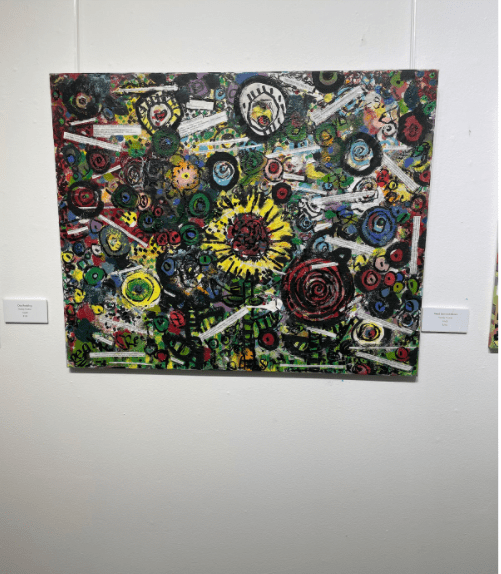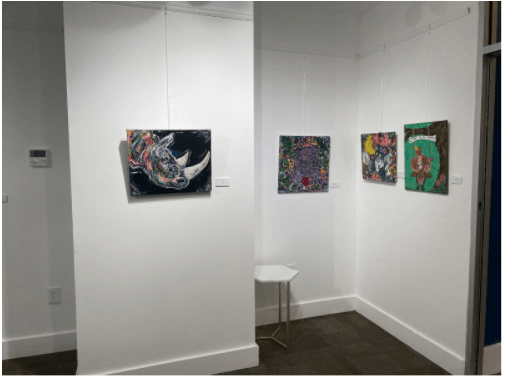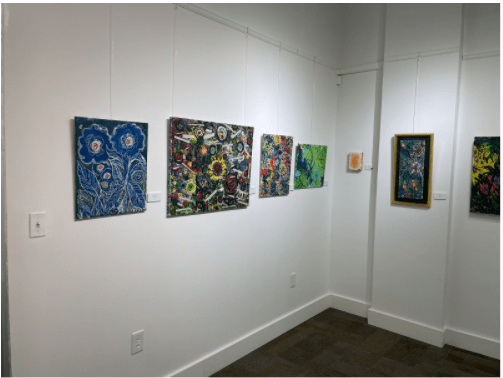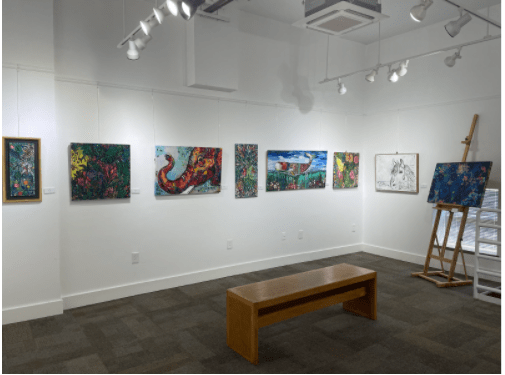Zoe Thompson
Art Markets Final




For this assignment, I attended a small exhibition that was being held at the Panama City Center for the Arts in Panama Beach City, Florida. The mission of this place was to bring the arts to the sweet small community that surrounded it. The arts center was clearly doing a good job at accomplishing this mission, as there were kids there for an art camp the week we visited, and they sounded like they were having a blast making art! Just as well, there was another exhibition going on in the other half of the building that held a host of skateboards that were painted by children and adults in the community. The skateboards were created in commemoration of the brand new skate park in the city, a park which took years of petitioning to build. There were little clips of news headlines about the park framed on the wall, which was an excellent way to provide important context for the exhibition. The gallery I attended, however, featured the work of an artist by the name of Heddy Podnar. Her exhibition was titled The Constant Gardener Returns Home: Exploring and Processing What Remains, and featured a myriad of paintings which all tied beautifully into the themes of nostalgia and injustices in the current world. My favorite of her pieces was one titled Read Banned Books. This piece included quotes from books that are officially on the banned books list for schools across America. Her exploration of the theme of censorship in a very abstract yet concrete way caught my eye, and if it hadn’t been out of my measly price range, I might have bought it.
The space itself was not very large. There was a wall of glass windows on one side of the room that faced out into the hallway of the arts center. On the other side of the room there was a small staircase that led to the back entrance into the gallery. The other two walls were a warm white, with large columns occasionally jutting out of them and into the space. The floor was a slightly outdated brownish-grey carpet that seemed to have seen better years. Despite the lack of professionalism and abundance of small imperfections in the space, it felt softer and kinder than the harsh professional galleries most people immediately think of. It made the space feel more homely, rather than aggressive and driven by capitalism. In a very odd way, this almost made me feel more obligated to buy the works that were featured, as it felt as though I was supporting a small artist who was just getting on their feet, rather than a professional who has been in the business for years.
The gallery was not meant for noise, however. Upon our first visit to the homely room, my family and I were completely alone. We are generally quiet people, so we did not utter more than a whisper while we were in the room, thus leaving the ambiance of the soft space unaffected. However, when I returned to snap some quick pictures of the works and the space before I left, a particularly noisy family had ambled into the room. Their loud, shrill voices filled the small room with ease, and left a horrid frustrating feeling with me. The echoes were unbearable and ruined the entire atmosphere of the room. I realized that, although the space has the benefit of being small and intimate, the audience in attendance of the gallery would most likely feature a large amount of noisy tourists. This realization made the gallery slightly less appealing, in all honesty. The staff, however, made up for the noisy tourists. They were the kindest people you will ever meet, and they all seemed genuinely excited about what they were doing there at the Panama City Center for the Arts. They seemed motivated to make a change in their community, and they were willing to invite anyone who walked into the building with wide open arms. Upon arrival, the man at the front desk greeted us warmly, almost as if we were family, and said, “Don’t mind the sounds of children and the few extra goldfish lying around on the floors. We are currently hosting one of our art camps, and the kids are a blast, but they are quite the mess! We will clean it up after the chaos has calmed down a bit. Thank you for your patience!” Despite his remarks, however, I never saw a single child-made mess on the floor.
The organization of the space itself was rather standard. There were spotlights on the ceiling that shone down on each of the selected artworks, and there was a standard bench in the middle for viewing. All of the artworks were arranged neatly in a line across the walls of the room. Pieces that were thinner were hung on the various columns, and pieces that were smaller were hung in the nooks between the columns and the walls. All of the works had small white plaques to the right of them that featured the names and information of the assorted works. Though the space was organized to maximize full functionality of the room, some of the works did get lost in the little nooks and crannies. For example, there was a small square canvas with a popsicle painted on it that we nearly missed the first time through, as it was so perfectly tucked away into its little corner. I did, surprisingly, like the look of the artworks hung on the columns. It added different levels to the space, which was a bit distracting, but still ultimately satisfying to view.
In comparison to the different art spaces we have read about throughout the course, this space seemed incredibly informal and relaxed. Though it still (loosely) followed many of the typical conventions of a gallery, it would not compare to a professional gallery in New York or Los Angeles. I believe that this space is still successful, however, as it manages to match its audience quite well. Ultimately, selling art is not necessarily about fitting the high art market mold, but about knowing your audience and your artists. This space achieved that goal, and I truly hope they continue to work in the more informal side of the art markets, as they have built a wonderfully warm and welcoming space for artists of all kinds.
This experience taught me a lot about the many different features that gallery owners have to take into account when building their spaces. The staff’s kindness, the general audience, the layout of the space, the types of works being shown, the overall monetary goal of the gallery. All of these things played a very important role in making or breaking my experience as a viewer. As an artist who will eventually move on to attempting to sell my own artwork, I will not forget the important lessons that visiting this gallery taught me. It will help me better determine the spaces I choose to sell my artwork in and galleries I choose to partner with. Overall, visiting this place was a wonderful learning experience, and I am glad I got to ever so briefly be a part of the wonderful family that is the Panama City Center for the Arts.